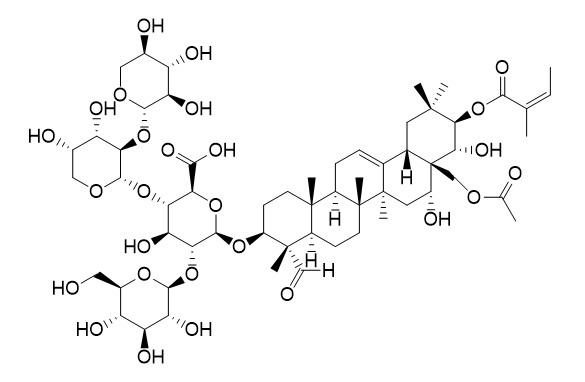Theasaponin E2
Theasaponin E2 has antitumor activity.
Inquire / Order:
manager@chemfaces.com
Technical Inquiries:
service@chemfaces.com
Tel:
+86-27-84237783
Fax:
+86-27-84254680
Address:
1 Building, No. 83, CheCheng Rd., Wuhan Economic and Technological Development Zone, Wuhan, Hubei 430056, PRC
Providing storage is as stated on the product vial and the vial is kept tightly sealed, the product can be stored for up to
24 months(2-8C).
Wherever possible, you should prepare and use solutions on the same day. However, if you need to make up stock solutions in advance, we recommend that you store the solution as aliquots in tightly sealed vials at -20C. Generally, these will be useable for up to two weeks. Before use, and prior to opening the vial we recommend that you allow your product to equilibrate to room temperature for at least 1 hour.
Need more advice on solubility, usage and handling? Please email to: service@chemfaces.com
The packaging of the product may have turned upside down during transportation, resulting in the natural compounds adhering to the neck or cap of the vial. take the vial out of its packaging and gently shake to let the compounds fall to the bottom of the vial. for liquid products, centrifuge at 200-500 RPM to gather the liquid at the bottom of the vial. try to avoid loss or contamination during handling.
Food Chem.2017, 228:301-314
Pharmaceuticals (Basel).2024, 17(3):341.
Int Immunopharmacol.2019, 71:22-31
Evid Based Complement Alternat Med.2021, 2021:8707280.
Molecules.2023, 28(13):4971.
Front Microbiol.2024, 15:1429027.
Cancers (Basel).2023, 15(1):293.
Nutr Cancer.2023, 75(1):376-387.
Biomed Pharmacother.2024, 179:117346.
Chin. Med.J.Res. Prac.2017, 31(4)
Related and Featured Products
Fitoterapia. 2013 Jan;84:321-325.
Phytochemical analysis of the triterpenoids with cytotoxicity and QR inducing properties from the total tea seed saponin of Camellia sinensis[Pubmed:
23266730]
The tea seed triterpene saponin (TS) from Camellia sinensis was found to exhibit better antitumor activity in vivo in S180 implanted ICR mice and QR inducing activity for hepa lclc7 cells respectively compared with the total tea seed saponin (TTS), hydrolysate of the TTS and tea seed flavonoid glycosides (TF). By bioassay-guided isolation, the TS fraction was separated and seven major components were purified and identified as theasaponin E1 (1), Theasaponin E2 (2), theasaponin C1 (3), assamsaponin C (4), theasaponin H1 (5), theasaponin A9 (6), and theasaponin A8 (7), among which compounds 4 and 5 were isolated from this genus for the first time. The antitumor bioassay of the isolated compounds showed that compounds 1, 2 and 3 exhibited potential activities against the human tumor cell lines K562 and HL60. Furthermore, compound 1 (the major constituent with a mass content of over 1%) showed significant QR inducing activity with an IR value of 4.2 at 4μg/ml. So it can be concluded that tea seed especially the compound 1 (theasaponin E1) could be used as an antitumor agent and a chemoprevention agent of cancer. The preliminary structure-activity relationship in the anti-tumor activity and QR inducing activity of tea saponins was discussed briefly.
Chem Pharm Bull (Tokyo) . 2000 Nov;48(11):1720-1725.
Bioactive saponins and glycosides. XVII. Inhibitory effect on gastric emptying and accelerating effect on gastrointestinal transit of tea saponins: structures of assamsaponins F, G, H, I, and J from the seeds and leaves of the tea plant[Pubmed:
11086901]
Following the investigation of assamsaponins A, B, C, D, and E, four new saponins termed assamsaponins F, G, H, and I were isolated from the seeds of the tea plant (Camellia sinensis L. var. assamica PIERRE), while assamsaponin J was isolated from its leaves. The structures of assamsaponins F-J were elucidated on the basis of chemical and physicochemical evidence and found to be 16,22-O-diacetyl-21-O-angeloyltheasapogenol E 3-O-[beta-D-galactopyranosyl (1-->2)][beta-D-glucopyranosyl(1 -->2)- alpha-L-arabinopyranosyl(1-->3)]-beta-D-glucopyranosiduronic acid, 21-O-angeloyl-22-O-acetyltheasapogenol E 3-O-[beta-D-galactopyranosyl(1--> 2)][beta-D-glucopyranosyl(1-->2)-alpha-L-arabinopyranosyl(1-->3)]- beta-D-glucopyranosiduronic acid, 21-O-angeloyl-28-O-acetyltheasapogenol E 3-O-[beta-D-galactopyranosyl(1-->2)][beta-D-glucopyranosyl(1--> 2)-alpha-L-arabinopyranosyl(1-->3)]-beta-D-glucopyranosiduronic acid, 21-O-tigloyl-28-O-acetyltheasapogenol E 3-O-[beta-D-galactopyranosyl(1--> 2)][beta-D-glucopyranosyl(1--> 2)-alpha-L-arabinopyranosyl(1-->3)]-beta-D-glucopyranosiduronic acid, and 16,21-O-diacetyl-22-O-cinnamoyltheasapogenol B 3-O-[beta-D-galactopyranosyl(l-->2)][beta-D-rhamnopyranosy(1-->2)- alpha-L-arabinopyranosyl(1-->3)]-beta-D-glucopyranosiduronic acid, respectively. The saponin mixture from the seeds of the tea plant was found to exhibit an inhibitory effect on gastric emptying and an accelerating effect on gastrointestinal transit in mice. Theasaponin E1 the principle saponin of the tea plant, showed potent activity, while Theasaponin E2 showed none, so that the position of the acyl groups in the sapogenin moiety is important from a pharmacological point of view.
J Biosci Bioeng . 2000;90(6):637-642.
Theasaponin E1 destroys the salt tolerance of yeasts[Pubmed:
16232924]
Cells of Zygosaccharomyces rouxii in a medium containing a high concentration of NaCl were killed during incubation for 2-4 h with a low concentration of a mixture of saponins from tea seeds (TSS). The higher the concentration of NaCl in the medium, the higher the inhibitory effect of TSS on the growth of the yeast. The above inhibitory effect of TSS on the growth of the yeast was not observed when cells were incubated in hypertonic media composed of nonionic substances such as sugars. The ATPase activity of plasma membrane preparations from the yeast cells was slightly affected by the addition of TSS. It is shown that TSS facilitates leakage of glycerol from the yeast cells under NaCl-hypertonic conditions. The major inhibitor in the mixture of saponins was isolated and identified as theasaponin E1. Its isomer, Theasaponin E2, did not have any effect on the salt tolerance of Z. rouxii or Saccharomyces cerevisiae.
Chem Pharm Bull (Tokyo) . 1998 Dec;46(12):1901-1906.
Structures of new acylated oleanene-type triterpene oligoglycosides, theasaponins E1 and E2, from the seeds of tea plant, Camellia sinensis (L.) O. Kuntze[Pubmed:
9880909]
Two new acylated oleanene-type triterpene oligoglycosides, theasaponins E1 and E2, were isolated from the seeds of tea plant [Camellia sinensis (L.) O. Kuntze]. The structures of theasaponins E1 and E2 were elucidated on the basis of chemical and physicochemical evidence to be expressed as 21-O-angeloyl-22-O-acetyltheasapogenol E 3-O-[beta-D-galactopyranosyl(1-->2])[beta-D-xylopyranosyl(1-->2)-alpha-L - arabinopyranosyl (1-->3)]-beta-D-glucopyranosiduronic acid and 21-O-angeloyl-28-O-acetyltheasapogenol E 3-O-[beta-D-galactopyranosyl(1-->2)][beta-D-xylopyranosyl (1-->2)-alpha-L-arabinopyranosyl (1-->3)-beta-D-glucopyranosiduronic acid, respectively. Theasaponin E1 was found to show antisweet activity.



